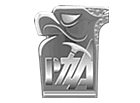South Col – South East Ridge Route – part 2.
Of the two main routes, the southeast ridge is technically easier and is the more frequently-used route. It was the route used by Edmund Hillary and Tenzing Norgay in 1953 / photo on the right /. With supplemental oxygen, Edmund Hillary of New Zealand and Sherpa Tenzing Norgay made their way to the top via the South Col, that became the most used climbing route to the summit.
In 1953, a ninth British expedition, led by John Hunt, returned to Nepal. Hunt selected two climbing pairs to attempt to reach the summit. The first pair turned back after becoming exhausted high on the mountain. The next day, the expedition made its second and final assault on the summit with its fittest and most determined climbing pair. The summit was eventually reached at 11:30 a.m. local time on May 29, 1953 by the New Zealander Edmund Hillary and Sherpa Tenzing Norgay from Nepal climbing the South Col Route. At the time, both acknowledged it as a team effort by the whole expedition, but Tenzing revealed a few years later that Hillary had put his foot on the summit first. They paused at the summit to take photographs and buried a few sweets and a small cross in the snow before descending. News of the expedition’s success reached London on the morning of Queen Elizabeth II’s coronation. Returning to Kathmandu a few days later, Hillary and Hunt discovered that they had been promptly knighted for their effort.
Mapka wyżej przedstawia drogę Edmunda Hilary’ego i Szerpy Tenzinga Norgaya :
Droga Edmunda Hilary’ego i Szerpy Tenzinga Norgaya, droga pierwszego udanego wejścia na szczyt z 29 maja 1953r., zwana też drogą klasyczną, a czasami ” łatwą” , ale to pozory bo wszak wiadomo, że w Wysokich Górach nic nie jest łatwe.
W tej pamiętnej wyprawie brało udział 10 Europejczyków i 39 Szerpów, a ciekawostka jest fakt, że tamta historyczna wyprawa założyła aż 9 obozów, obecnie zakłada się jedynie : obóz bazowy – zwany też BC i cztary obozy wyższe, czyli razem 5. Droga na szczyt wiodła wtedy od obozu I (5400m) na lodowcu Khumbu (obecnie obóz I to właśnie BC ), przez Iceffal z wielkimi i groźnymi szczelinami oraz serakami ( wielu twierdzi, że przejście Iceffalu to loteria o śmierć i życie ), aż do obozu IV (6400m) założonego w bezwietrznym wąwozie, który himalaiści nazwali Dolina Ciszy, a dalej nad Kotłem Zachodnim założono obóz VII (7300m), skąd wspinacze wspinali się na Przełęcz Południową do obozu VIII (7900m), a potem do obozu IX (8500m), stąd nastąpił atak szczytowy granią szczytową poprzez Wierzchołek Południowy i uskok przed szczytem dziś zwany uskokiem Hilary’ego.
Wejście na Everest miało być prezentem koronacyjnym dla Elżbiety II.
Other Routes – part 1.

A – 1953, a ninth British expedition, led by John Hunt, via the South Col, Nepal.
B – On May 19, 1980 Andrzej Czok and Jerzy Kukuczka (on the Polish National Expedition led by Andrezej Zswada) established a new Everest route by following the South Pillar on the right-hand edge of the Southwest Face.
The South Pillar
Another relatively safe route up Everest – if there really is such a thing as a “safe” route on Everest! – is the South Pillar, first climbed in 1980 by Polish super-alpinists Jerzy Kukuczka and Andrzej Czok.
The route has been climbed in it’s entirety a total of 17 times with one fatality. The Polish team spent 16 days establishing the route through the difficult rock barriers towards the top of the route, so many climbers opt to traverse across to the SE Ridge lower down.
28 climbers have traversed over from this route and safely summited. The one fatality that occurred on the complete S Pillar route was Josef Psotka in 1984, who after successfully summiting was killed in a fall, but it was from the Lhotse Face while descending the standard SE Ridge route. So to date there have been no fatalities on the South Pillar itself.
Na zdjęciu czerwone linie pokazują drogi na szczyt.
A- Brytyjska droga z 1953r wiodła m.in. przez Wierzchołek Południowy.
B- Polska droga z 1980r wiodła wzdłuż południowego filara.
Droga polska została wytyczona przez wyprawę kierowaną przez Andrzeja Zawadę, pierwsze wejście południowym filarem, a ściślej miedzy filarem a południowo -wschodnia granią; 19 maja 1980r na szczycie stanęli Jerzy Kukuczka i Andrzej Czok. Ciekawostka jest, że Zawada kierował nieco wcześniej wyprawą zimową. Pamiętna wyprawa i wielki sukces polskich himalaistów, bo po raz pierwszy w zimie, 17 lutego 1980r szczyt Everestu zdobyli Leszek Cichy i Krzysztof Wielicki.
Przypomnę też, że drogą klasyczna, drogą pierwszych zdobywców, szczyt zdobyła też gwiazda TVN – Martyna Wojciechowska, 18 maja 2006r jako trzecia Polka stanęła na Everescie ; posty o wyprawie Martyny są tez na moim drugim blogu w dziale wyprawy , zobacz : Everest dla kazdego.. czy to prawda??, Puja.. dary dla Bogow.
Zapraszam też do oglądania albumu o Everescie, wystarczy kliknąć link : Odkrywanie Everestu
Filed under: drogi do celu, Expedition, Routes, travel | Tagged: Andrzej Czok, Andrzej Zawada, Base Camp, Edmund Hillary, Everest, Expedition, Jerzy Kukuczka, Khumbu glacier, Khumbu Icefall, Lhotse, Nuptse, routs, South Col, Tenzing Norgay, Western Cwm | 2 Comments »

















































